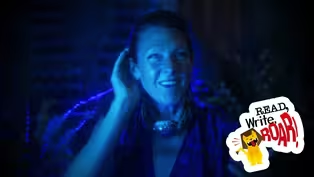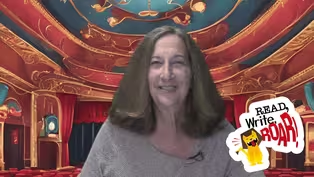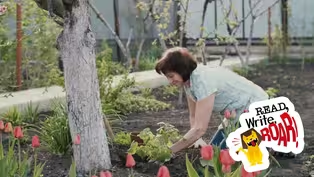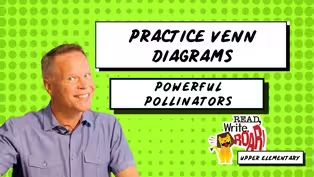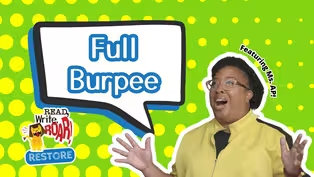Read, Write, ROAR!
Michigan's Native Plants
Season 1 Episode 1022 | 26m 45sVideo has Closed Captions
Learn about how native bees help plants, and what we can do to help protect their habitats.
Learn about how native bees keep our native plants going, and what we can do to help protect their habitats. Then learn about how native plants are used in urban landscaping. Let's go Read, Write, ROAR!
Problems playing video? | Closed Captioning Feedback
Problems playing video? | Closed Captioning Feedback
Read, Write, ROAR! is a local public television program presented by Detroit PBS
Read, Write, ROAR!
Michigan's Native Plants
Season 1 Episode 1022 | 26m 45sVideo has Closed Captions
Learn about how native bees keep our native plants going, and what we can do to help protect their habitats. Then learn about how native plants are used in urban landscaping. Let's go Read, Write, ROAR!
Problems playing video? | Closed Captioning Feedback
How to Watch Read, Write, ROAR!
Read, Write, ROAR! is available to stream on pbs.org and the free PBS App, available on iPhone, Apple TV, Android TV, Android smartphones, Amazon Fire TV, Amazon Fire Tablet, Roku, Samsung Smart TV, and Vizio.
Providing Support for PBS.org
Learn Moreabout PBS online sponsorship- On "Read, Write, Roar!"
learn about how native bees keep our native plants going and what we can do to protect their habitats.
Then learn about how native plants are used in urban landscaping.
Let's go, "Read, Write, Roar!"
- [Announcer] This program is made possible in part by the state of Michigan and by and by viewers like you.
Thank you.
(energetic music) - Have you heard all the buzz about bees lately?
I know I have.
Hey, it's me, Mr. Peterson, and today we're going to examine two bees that are native or found naturally in Michigan.
Bees can definitely be described as busy, busy transferring pollen between plants, but what is pollen?
Pollen is a substance created by plants needed to help them to go to seed or produce fruit.
Some of you might be allergic to pollen.
That's because it's usually a fine powder that can make us sneeze.
I guess that makes sense because the Latin meaning for pollen is fine flour, like what we use to bake cookies.
Pollinators like bees help to pollinate, and that means that they spread the pollen from one plant to another to help them go to seed and produce fruits.
This whole process is known as pollination.
If you look carefully, you can see the root word of pollen in the words pollinate, pollinator and pollination.
The spelling changes just a bit with the E in pollen changing into an I when we add a suffix, but all of these words are related in meaning.
Now let's learn about two different kinds of bees who are native to Michigan and who work as pollinators.
Take notes with me as we learn, then I can use those notes to help write a comparison.
The first native bee is the mason bee.
Mason bees are solitary bees.
This means they live alone and don't live in colonies or groups like the non-native honeybee.
Mason bees live underground and get their name because they use mud or mason products to construct their nest inside of the empty stem or tube.
Humans that work with brick and mortar or mud are known as masons.
In the tube, the bee lays an egg.
Then it adds some pollen that is collected from flowers for the larvae to eat.
Before the larvae hatches, the mason bee protects it by packing in some mud into that tube.
The mason bees usually build their nest in the months of May and June.
The second species of bee is the leaf cutter bee.
Solitary and living underground, they also get their name from how they build their nest.
They use their mandibles, which are sharp mouth parts used to cut pieces of leaves.
They lay an egg, add some pollen that it collected from the flowers for the larvae to eat when it hatches and then protect it by packing in the piece of leaf they cut.
Leaf cutter bees usually build their nest in the month of July.
Since I'm comparing two different types of bees, the mason and the leaf cutter bees, I'm going to use a Venn diagram.
A Venn diagram has two circles that overlap in the center.
In this overlap, I'll write what is alike or similar about the two kinds of bees.
In the parts of the circle that do not overlap, I will label one side mason bees and one side leaf cutter bees and write what is different about them.
Okay, so we learned that both bees are native or found naturally in Michigan.
We also learned that they both live underground.
Both bees use empty stems or tubes to build the nest for laying eggs and putting in some pollen for the larvae to eat.
Now let's look at the differences.
The mason bee uses mud to make its nest and the leaf cutter uses leaves.
The mason bee builds the nest in the months of May and June, and the leaf cutter builds the nest in July.
The leaf cutter bee also has special mandibles to help it cut leaves.
Let's check out a comparison writing I did.
Because this is a comparison writing, I use the following words and phrases.
I use similarities, differences, but, additionally, these are all frequently found in this type of writing.
While I'm reading aloud, follow along so you can see how the Venn diagram helped me organize and write my comparison paper.
There are two bees in Michigan that have many similarities.
Some also have some differences.
Mason bees and leaf cutter bees are both bees that are native to Michigan and live underground.
Additionally, each species uses tubes or hollow sticks to build their nest and pack pollen in the tubes after laying an egg so the hatching larvae has food to eat.
When looking at these two native bees, it is equally important to notice some of the differences they display.
To protect the larvae and pollen, the mason bee uses mud, but the leaf cutter bee uses pieces of leaves that it cuts with its sharp mouthpiece known as a mandible.
Finally, they both build their nest at different times in the year.
The mason beads are first to perform this task in May and June while the leaf cutter bee does it in July.
Even though these important pollinators behave like each other in some ways, they also have behaviors that make them unique from each other.
What do you think?
We just learned a lot.
We learned about the process and importance of pollination and how to use a Venn diagram to help us organize our information and notes in order to do comparison writing.
Pollen can make us sneeze, and bees might make us a bit nervous, but there's no denying how important native pollinators are to the world around us.
(energetic music) (upbeat music) - Ms. AP here to help restore your energy.
Before we begin, let's start with our warmup by doing two forward folds.
Standing your tall mountain, arms up, folding over, feeling that stretch, rolling up.
One last time, arms up, folding over, feeling that stretch, rolling back into your tall mountain.
Nice job.
Now that we have warmed up our body, we are ready to exercise.
Today we are gonna continue our practice of burpees, and I have a few new moves to show you.
We will start in our ready position, feet apart, hands at your sides.
We're gonna go down into our squat position, hands on the floor.
Remember, kick your feet out, kick them back in.
This time when we come up, big jump.
Reset yourself again.
Squat down, hands on the floor, kick your legs out, kick your legs back in.
When you come up, big jump.
One last time.
Squat down, hands on the floor, kick your legs out, bring them back in.
Big jump.
Reset your body.
Give yourselves a big clap, clap (claps).
Nice job.
Let's cool down by taking two deep breaths.
Deep breath in.
Deep breath out.
Deep breath in.
Deep breath out.
Great job.
(upbeat music) (energetic music) - This lighthouse has saved countless ships and people's lives lives, and it did that by taking the light from a little lantern and shooting it out for about 15 miles.
But how did it do that?
Hey, I'm Alexis!
I'm visiting the Marquette Harbor Lighthouse to learn more about how lighthouses on Lake Superior work, and what I've been learning is so cool.
I wanted to bring you along.
So this is the light that powers the lighthouse.
Today, it's an automatic light, and it runs on electricity.
When it gets dark, a light bulb inside this lens lights up, and this plastic cap spins to make it look like the light is flashing on and off.
For the most part, this light takes care of itself.
You can turn it on at night and then go to bed and not really have to worry about it, but that hasn't always been true.
One big question I had about lighthouses is how they work.
Like we saw this powerful electric light, but in 1866 when this lighthouse was first built, most people didn't have electricity.
They used oil lanterns like I mentioned earlier, except oil lanterns aren't very big.
You can, you know, hold them in your hand, and their light normally doesn't shine very far.
But this light sent out a signal for about 15 miles.
So how?
Well, let's head over it to the Marquette Maritime Museum.
I've got something to show you.
Welcome to the Marquette Maritime Museum.
You can learn all about Lake Superior here, but I wanted to show you this room.
Specifically I wanted to show you these lenses.
They're called Fresnel lenses, and starting around 1820, they help lighthouses shine their light to sailors miles away.
There are different sizes of Fresnel lens depending on how far you need your light to go.
The Marquette Harbor Lighthouse used to have what's called a fourth order lens.
It's about right in the middle as far as sizes of Fresnel lens go.
Fresnel lenses are made of a bunch of carefully shaped pieces of glass arranged into sort of a dome like this one.
Then the lighthouse keeper would put their oil lantern on a stand right in the middle together.
The pieces of glass in a Fresnel lens work like a bunch of magnifying glasses.
They capture almost all of the light shining out in all directions from the oil lantern and then reflect that light into one super bright straight beam, like a giant flashlight.
This makes the oil lantern way brighter than it would be on its own.
So bright, it can shine for miles.
Now, the reason we're at a museum right now and not over at the lighthouse is because today most lighthouse don't have Fresnel lenses like this.
They've been replaced by electric lights that use a similar technology, but they're not quite the same.
Still, the general idea behind Fresnel lenses has spread way beyond the lighthouse world.
Engineers have taken this basic design and used it to make all kinds of things, including tools that have helped a satellite in space collect sunlight to power its equipment.
Today, lighthouses help ships stay safe on Lake Superior, on the Great Lakes and on seas and oceans around the world, and I loved getting the chance to learn more about how they worked and what it was like to take care of one.
If you ever get a chance to visit a lighthouse or a lighthouse museum, try to see if they have the original Fresnel lens, and if it looked different from the ones we saw today, see if you can figure out why.
For now, thanks for joining me on the trip to the Marquette Harbor Lighthouse.
I'm glad you came.
(energetic music) - Hi, scholars, Mrs.
Mask here.
I love to write, and narratives are one of my favorite types of writing.
It's important as writers that we review and revise our writing so we continue to improve and make it the best final product we can.
Narrative text has many different elements or parts.
I've selected four of those to focus on with you today.
This will help me identify where I want to make revisions in my writing.
Let's take a look at the elements we've selected.
Interesting beginning.
Do I get the reader's attention right away?
Natural flow of sequence of events.
Are my events in an order that makes sense to readers?
Descriptive details.
Do I describe the events, people and other things clearly so readers can picture them in their heads?
Conclusions that follow sequence of events.
Does my conclusion or ending make sense and follow what happened.
After reading my narrative, we will use this list to guide my revisions.
"Lisa's Native Yard Revolution."
A few years ago, Lisa wanted to do something different with her small front yard.
She lived in Bay City where most of the space was covered with concrete buildings and streets.
Her neighbors had regular lawns with short grass, hedges and flowers from the garden store.
Lisa wanted something more natural and better for the environment.
After looking online, she learned about using native plants in her yard.
Native plants are plants that grow naturally in an area.
At first, the idea seemed odd.
She was used to seeing perfect gardens in magazines with plants from other places.
But the more she learned, the more she liked the idea.
Native plants were easier to care for.
They attracted birds and butterflies and were made for the local weather.
One Saturday, Lisa went to a nursery that sold native plants.
The owner showed her tall grasses that waved in the wind, wild flowers with soft, purple and yellow blooms, and bushes with berries that birds would eat.
Lisa felt excited to try something new and bought a few plants, purple cone flowers, black-eyed Susans and native grasses.
As she planted them in her yard, her neighbors watch with curiosity.
"Why not just plant roses or petunias like everyone else?"
one of them asked.
Lisa explained that native plants like purple cone flowers and black-eyed Susans didn't need as much water as roses and petunias and wouldn't need chemicals to grow.
She told her neighbors how their deep roots would help prevent the ground from washing away when it rained, which is important because the neighborhood often flooded.
After a few weeks, Lisa's yard was completely transformed.
The native plants started to bloom, and her yard became a little patch of nature in the middle of the city.
She loved watching butterflies visit the flowers, and birds stopped by to eat berries from the bushes.
Her yard felt peaceful and different from the structured fast look of the city.
Before long, Lisa's neighbors began to ask more questions.
One by one, they became interested in native plants too.
Lisa even held a small workshop in her yard showing them how easy it is to plan and take care of them.
Soon the whole neighborhood started to change.
Neat lawns and store bought flowers were replaced by colorful lively landscapes full of native plants.
Lisa's idea turned into a big neighborhood project.
The area looked better and healthier.
People noticed fewer floods after rain, and the air seemed fresher with all the plants cleaning it.
Native plants weren't just for the wild.
They found a perfect place in the city.
Lisa realized using native plants was more than just having a pretty yard.
It was about helping the environment and making a small positive change, and that change spread further than she ever imagined.
Now let's use the chart to find examples of each of the four elements I'm focusing on today for my revision.
Do I have an interesting beginning, yes or no?
I think this introduces the story well, but is it interesting?
Maybe, I wonder if I could start with a question that might get the reader more excited.
I'm gonna mark no and go back and see what I can add.
Is there a natural flow of sequence of events?
Well, it starts with Lisa evaluating her yard, considering what to buy, shop, planting native plants, and then working with her neighbors to do the same.
I'd say yes to this.
I did descriptive details?
Well, neat lawns, colorful, lively landscapes, wild flowers with soft, yellow and purple blooms and bushes with berries are descriptive, but I do think I could do better by adding sensory language, words that appeal to the five senses.
Sight, sound, smell, taste, and touch.
I'll mark this a no.
And finally does my conclusion follow the sequence of events.
I'm going to say that this conclusion follows the sequence of events since it includes a little bit about the beginning, the middle, and the end of the writing.
Wow, I did a great job, but this writing will be even better after I add to my introduction and use sensory language.
Remember, when you write, it's important to revise so our writing is clear and interesting for the reader.
There's always room to grow as a writer.
(energetic music) - Hello, I'm Miss Audra, and today we're taking a deep dive into the ocean.
So I want you to start to think about all the songs you might hear under the water.
First, let's take our breath together.
Here we go.
And I'm gonna blow mine out like little bubbles.
Bloop, bloop, bloop, bloop, bloop.
Nice, breath in, and blow it out any way you want today.
Nice.
So again, think about all the sounds you might hear.
You might hear the sound of the whale.
Or a fish or a crab walking along the bottom.
What might you hear today?
And don't forget to use your hand, your arms, or your whole body today.
Alright, so put it in your mind.
And on the count of three, make your sound, and I'm gonna make my sound two after I listen.
1, 2, 3.
All right, I'm make my sound.
Nice, and on the count of three, we're gonna pause, 1, 2, 3.
Nice, wow.
The beautiful sounds of the underwater soundscape that we created today.
You can do that anytime in your mind, whenever you want.
Before we say goodbye, let's take that last balancing calming breath together.
And hold and blow out like bubbles.
Bloop, bloop, bloop.
See you next time.
(energetic music) - The scene I'm working on for my next film script is about the importance of pollinator gardens.
Pollinators like bees help to pollinate, and that means they help by spreading pollen from one plant to another to help them seed and produce fruit.
People who have pollinator gardens help different animal species such as honeybees and monarch butterflies from becoming extinct.
In order to describe my garden, I need to use more than just words.
I need to show it.
Oh, hello, scholars.
I'm media literacy, Maddie.
When a media maker creates a scene for their characters, it's called the setting.
The setting is kind of like a magical place that lets the viewers of the film know many different things about the story.
The setting includes the location.
This is where the story takes place.
Time period, when the story happens.
Events, what happens in the story.
The setting also includes mood, which is the story's tone or feeling.
I think my garden is a perfect spot for the setting of my film on pollinator gardens because it is a likely location or setting to find pollinators such as bees and butterflies.
Let's find Miss Kara.
She's watching a film about the March on Washington, while also learning about setting in film.
Hello, scholars.
It's so good to see you.
I've been viewing the documentary film, "Detroit's Walk to Freedom, to the March on Washington, 60 Years of Civil Rights Legacy."
This film was produced by One Detroit for Detroit PBS.
As I've been viewing, what I noticed immediately was that the film producer wanted to highlight the city of Detroit in a positive way.
They did that through the settings they chose for each of their film shots in this documentary.
In this section of the film, they showed large groups of people walking peacefully together.
They showed important landmarks like the tracks for the Detroit people mover, as well as the Fox Theater, which is in the theater district downtown on Woodward Avenue.
Though this section does have narration, I've turned it off so that we can concentrate only on the visuals that establish the setting.
Turning off narration is a good technique to try when you really wanna concentrate on analyzing just the visuals in a film.
As you watch this video clip, focus on the setting that the media maker included, which shows it was a peaceful day in downtown Detroit.
What do you notice?
(lively music) In addition to showing the peaceful setting of Detroit, the media took the viewer back in time by including historic black and white images to show what the march looked like in 1963.
Now it's your turn to create the setting for a couple of scenes in your own film.
Do you have a piece of paper and a pencil handy?
If you were going to record a scene of kids playing at a park, what would the setting look like?
Hmm, I'm going to write sand box and swings.
Just like the words and pictures in a book described for readers where the characters are and what's happening around them, the setting in a film scene does the same thing.
The setting is like a magical background that helps bring the film to life and makes it more interesting and fun to watch.
What's the next show or film you plan to watch, and how do you think the setting will make the story more meaningful and exciting?
- Thank you so much for watching.
For activity guides, videos, lessons, and so much more, be sure to visit our website, michiganlearning.org.
And don't forget to read, write, roar!
- [Announcer] This program is made possible in part by the state of Michigan and by and by viewers like you.
Thank you.
(energetic music) (energetic music continues) (bright music)
Create an Underwater Soundscape | Ms. Audra | Read, Write, ROAR!
Video has Closed Captions
Clip: S1 Ep1022 | 2m 18s | Dive into the ocean with Miss Audra! Explore the sounds of whales, fish, and bubbles. (2m 18s)
How to Create a Strong Setting in Film | Ms. Kara | Read, Write, ROAR!
Video has Closed Captions
Clip: S1 Ep1022 | 4m 29s | Discover how the setting in film contributes to the overall story. (4m 29s)
Native Plants: Transforming Urban Landscapes | LaDonna Mask | Read, Write, ROAR!
Video has Closed Captions
Clip: S1 Ep1022 | 7m 31s | Explore how native plants can transform urban areas! (7m 31s)
Pollination Power: Native Bees | Venn Diagrams for Grades 4-5
Video has Closed Captions
Clip: S1 Ep1022 | 6m 25s | Join Mr. Peterson as he explores two native Michigan bees and their role in pollination. (6m 25s)
Read, Write, ROAR! Restore - Full Burpee
Video has Closed Captions
Clip: S1 Ep1022 | 2m 24s | Full Burpee: Join Ms. AP in a dynamic 2-minute movement snack focusing on jumping burpees. (2m 24s)
Providing Support for PBS.org
Learn Moreabout PBS online sponsorship

- Home and How To

Hit the road in a classic car for a tour through Great Britain with two antiques experts.












Support for PBS provided by:
Read, Write, ROAR! is a local public television program presented by Detroit PBS
